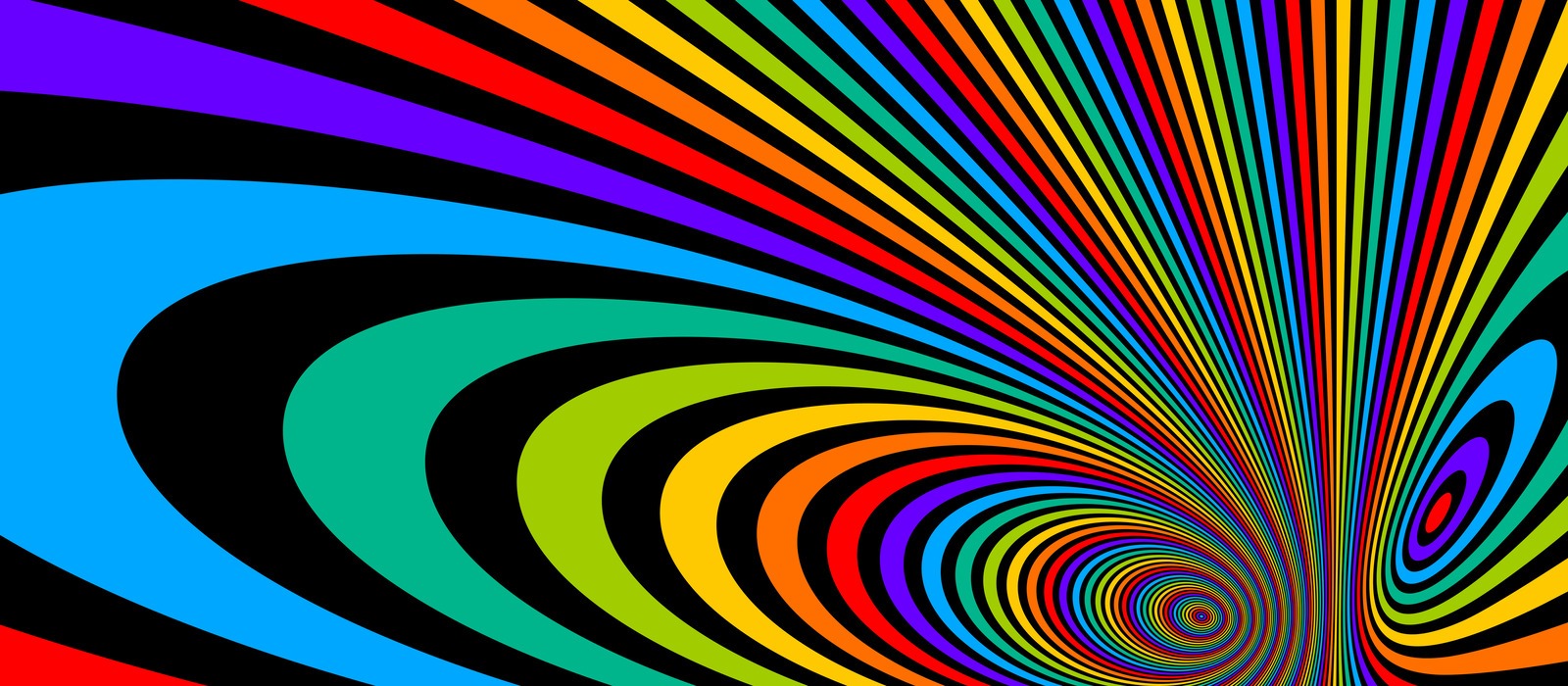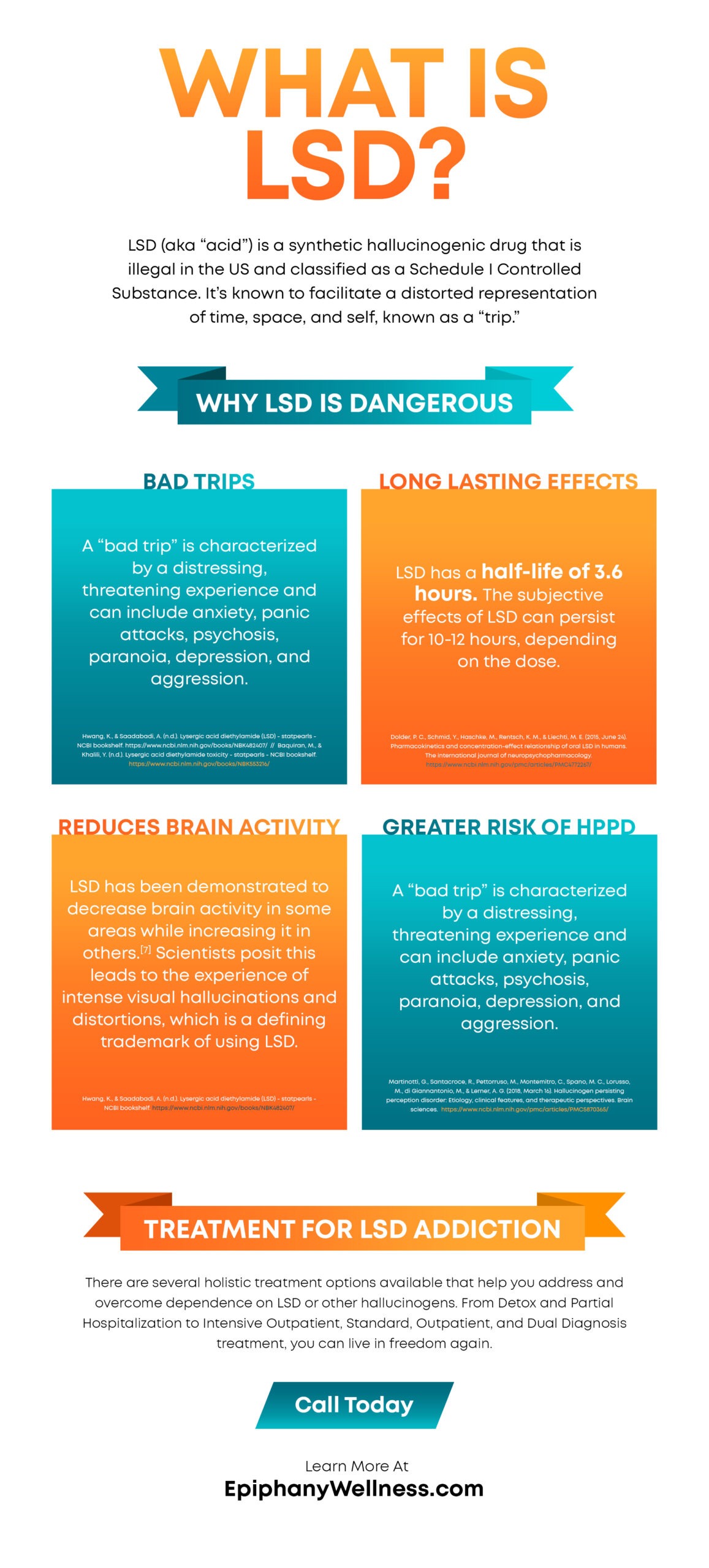What Is LSD? [Infographic] Usage, Side Effects, Dangers, and Health Risks

- In 1938, LSD was discovered by accident by Albert Hoffman and is a hallucinogen.
- LSD interacts with serotonin receptors in the brain.
- The Criminalization of LSD started in the 1960s.
- The reported experience of good trips vs. bad trips is significant enough that precautions should be taken.
- Long-term use of LSD is associated with tolerance, flashbacks, and HPPD.
Everything You Need to Know about LSD
LSD, also known as “acid,” is a synthetic hallucinogenic drug that is classified as a Schedule I controlled substance in the United States, making its possession, use, and distribution illegal without authorization for research.
It is famous for its quality of “tripping,” in which users of the drug experience a distorted representation of time, space, and self. Adverse side effects are more common with heavy doses of the drug and can include subjectively distressing mental health episodes.
Although LSD is currently illegal outside of authorized research, ongoing scientific studies are investigating its potential therapeutic benefits for various psychiatric conditions.
What are Hallucinogens?
Hallucinogens are a class of drugs (including LSD, PCP, mescaline, and psilocin) that make users feel disconnected from their bodies while experiencing the world in a distorted way.[1]
Hallucinogens are popular as party drugs, as they can induce relaxation and openness to experimentation in people who would otherwise have strong inhibitions against either practice.
A study on ecstasy use in young adults found that heavy users were likelier to report sexual risk-taking than non-heavy users.[2]
In the United States, many hallucinogens are classified as Schedule I controlled substances, making unauthorized possession, distribution, and use illegal. However, certain hallucinogenic substances may have different legal statuses or may be used in research settings under specific regulatory approvals.
What is Acid?
LSD (aka “acid”) is short for Lysergic acid diethylamide. It is a classical hallucinogen with an extremely small threshold dose to experience the effects: Just 15 micrograms.
That’s just 15 millionths of a single gram. To give you an idea of just how small that is, if the diameter of the earth (12756.2km) represented a single gram, 15 millionths of the diameter of the earth is the length of two football fields (191.34m).
LSD acts on the serotonin receptors in the brain. Serotonin is a neurotransmitter responsible for the subjective experience of cheerfulness, optimism, and happiness.[3]
Many people describe low doses of LSD as a non-threatening “spiritually meaningful” experience.[4] This is perhaps due to how it binds to the serotonin receptors and the major signaling pathways it activates.
LSD’s Mechanism of Action
LSD appears to interact with a particular serotonin receptor called 5-HT2AR.[5]
While serotonin can use G-proteins and through β-arrestins as signaling pathways, LSD mostly binds so that only the β-arrestin pathway is used.
The molecule gets sealed by the serotonin receptor, which could be the reason why its effects are so long-lasting. LSD-activated 5-HT2AR receptors break down the inhibitory processes in the hippocampal prefrontal cortex.[6]
Specifically, it has been demonstrated to decrease brain activity in some areas while increasing it in others.[7] Scientists posit this leads to the experience of intense visual hallucinations and distortions, which is a defining trademark of using LSD.
There is some evidence that LSD can affect neuroplasticity, suggesting a theoretical basis for the treatment of chronic mental disorders.[8]
Half-Life of LSD
The half-life of a given substance is the time it takes for 50% of the substance to be eliminated from the body. It takes 4-5 successive half-lives to statistically eliminate a substance from the body (<95%).
LSD has a half-life of 3.6 hours.[9] It should be statistically eliminated from the body between 14.4 and 18 hours after the final dose.
The subjective effects of LSD persisted for around 10-12 hours, depending on the dose.[10]
Methods for Administering LSD
LSD is a powder or liquid that can have a slightly bitter taste. Most often, LSD can be administered orally through an individual “tab.” A film of LSD is laid down on a sheet of absorbent “blotter paper.”[11] This will be subdivided into small, decorated squares that can be detached from the main paper and transferred to the user.
These saturated LSD squares are laid on the tongue to dissolve. It can also be ground and mixed into sugar cubes, added to a drink, or taken through a tablet/capsule.
Environment for Administering LSD
Some people use LSD as one of several different club drugs; many people prefer to take it in a quiet environment. The intense experience of synesthesia can occur regardless of the environment in which it is taken.
Physical Appearance of LSD
“Blotter paper” is often colorful paper superimposed with innocuous-looking designs. Any tablets or capsules could also be colorful. Blotter paper is often colorful with various designs not necessarily to resemble candy but to differentiate between different batches or to appeal to users visually.
Street Names for LSD
| Drug Category | Commercial & Street Names | DEA Schedule | Administration |
| Hallucinogen | (No commercial names)
Street names: Acid, blotter acid, dots, mellow yellow, window pane |
Schedule I | Orally |
History of LSD
1930s to 1940s
LSD was first synthesized in 1938 by Swiss Chemist Albert Hofmann as he worked for the chemical company Sandoz. He was interested in building synthetic derivatives of compounds from “ergot,” a type of fungus that grows on cereal plants like wheat and rye.
In the high doses of natural doses, ergot caused an extremely painful disease historians now attribute to the painful malady “St. Anthony’s Fire.”[12] But in low doses, its vasoconstricting properties could be helpful to manage post-delivery hemorrhaging in new mothers.
He combined random organic molecules with the chemical compounds isolated from ergot to create synthetic alternatives that could reasonably have the same effect but without the possibility of disfiguring disease.
The 25th such experiment did not produce the desired results, but it did make the test animals very excitable.[13] Ultimately, it was thrown out and not further investigated.
Five years later, during the middle of World War 2, for reasons still unknown, Albert Hoffman synthesized the compound again. He dissolved 250 micrograms of the substance in water, drank it, and experienced significant psychoactive effects as he rode his bicycle home, an event now known as “Bicycle Day.”
He was the first person in history to intentionally dose LSD. From that point, the use of LSD spread around the world.
1950s to 1960s
Under the auspices of a project codenamed “MK-Ultra,” America’s Central Intelligence Agency (CIA) attempted to use LSD and other hallucinogens as espionage truth serum agents. The thought was that LSD would render a subject (such as a spy) unable to lie.[14] Unfortunately, the only dependable result was to render the subject unable to be coherent.
In the 1960s, LSD began to be associated with a growing counter-cultural movement. The de-facto mantra of the counterculture movement (“Turn on, tune in, and drop out”) was greatly facilitated by the primary effects of LSD.
In 1970, during a now-famous stunt, a cargo plane flew over a hippie rock concert and scattered 4 million doses of “Orange Sunshine” LSD onto the concertgoers below.[15]
Drug Scheduling of LSD
In 1968, the Nixon administration saw a threat to re-election in the antiwar left and promptly began to wage a war on drugs.
John Ehrlichman, White House counsel to President Nixon, said, “If we could get the public to associate marijuana with hippies… and then criminalize them heavily, we could disrupt those communities.”[16]
LSD became illegal in 1968 in the United States following an amendment to the Federal Food, Drug, and Cosmetic Act of 1938.[17] It was solidified in 1970 by the passage of the Controlled Substances Act, which categorized allowable vs. non-allowable drugs by scheduling.
LSD was, and still is, a Schedule 1 controlled substance. That means it has no approved medical uses and is illegal to possess in any amount.
Criminalization of LSD
In a criminalization model, drug users accrue civil fines and an increasing level of punishment for recidivist offenses.
Following the passage of the United States’ “Controlled Substances Act” in 1970, the United Nations hosted the Convention on Psychotropic Substances in 1971.[18]
Since the United Nations had no legislative power to reach across borders, it could not directly outlaw LSD in member countries. But, it simply passed off that responsibility to the delegates once they returned home.
Over the next few years, 184 of 195 countries worldwide adopted the prohibitions against hallucinogens, including LSD.[19]
Decriminalization of LSD
In a decriminalization model, drug users get diverted from the court system to treatment centers. They receive clean needles and get enrolled in abstinence programs.
In 2001, Portugal decriminalized all illicit drugs, including LSD, though the efficacy of that legislative overhaul now appears mixed.[20] In 2022, the Canadian province of Alberta decriminalized all psychedelics, including LSD, for therapeutic use.
A 2016 study by De Gregorio et al. analyzed the therapeutic potential of hallucinogens, including LSD, to modulate functional brain connectivity.[21]
More and more countries, states, and municipalities are decriminalizing LSD.
Primary and Secondary Effects of Taking Acid
The minimum threshold dose for LSD is 15 micrograms, while a heavy dose of LSD would register somewhere in the neighborhood of 300 micrograms.[22]
The act of taking LSD is colloquially known as an “acid trip.” “Good trips” are characterized by subjectively positive, non-threatening experiences, whereas “bad trips” are characterized by subjectively distressing experiences.
Deaths from LSD overdose are extremely rare.[23] The primary effect of LSD is mental, although there are some physical effects.
“Good Trip”
A “good trip” is characterized by a pleasant, non-threatening experience.[24]
This commonly includes synesthesia, which is experiencing more than one sense simultaneously, such as smelling colors. This happens because your brain routes sensory stimuli through multiple unrelated senses.
A distorted sense of time and identity are both often present. The paradoxical experience of depersonalization, or feeling disconnected from your own body, is often reported. Lastly, good trips tend to include artificial euphoria and certainty.
Interestingly, many defined increased religiosity and spirituality as a “good trip.” Many users of LSD have a subjective “God-encounter” after taking the drug.[25]
In one study of 4,285 people who reported “God-encounters,” nearly 30% had experienced God-encounters through LSD use.[26] ⅔ of all study participants who identified as atheists before a “God-encounter” no longer identified as atheists afterward.[27]
“Bad Trips”
A “bad trip” is characterized by a distressing, threatening experience.[28][29]
A “bad trip” of LSD use can include adverse mental health episodes such as anxiety, panic attacks, psychosis, paranoia, and depression.
Aggression has also been reported, though this was likely a reaction to an adverse mental episode. During this time, suicidal ideation can occur as well.
One of the most distressing experiences of a “bad trip” is a flashback. Flashbacks can be induced by stress or fatigue or by other drug use.[30] It can happen without warning, even if the user does not currently have LSD in their system.
Possible Therapeutic Uses
While research on LSD in the United States was heavily restricted following its prohibition, studies have resumed in more recent years, particularly related to its potential therapeutic uses. One modern study systematically reviewed 11 articles published in this time frame related to LSD trials:[31]
- The most positive results were the efficacy of LSD in improving psychiatric symptomatology for patients experiencing alcoholism.
- The study reviews indicated that while there were statistically significant short-term improvements in well-being for patients with conditions such as alcoholism, the long-term outcomes were not consistently different from those who did not receive LSD.
LSD Addiction Withdrawal Symptoms
While LSD primarily interacts with serotonin receptors, it can also affect dopamine receptors, but its mechanism of action does not typically lead to physical dependency. Most of the dependencies developed with LSD use are psychological, not physical.
Flashbacks are an extremely adverse symptom of LSD withdrawal. Without warning, an individual can have anxiety, panic attacks, and depression associated with “bad trips.”
They are a highly distressing experience that can happen regardless of how long it has been since the user last had LSD in their system.
Also, Hallucinogen Persisting Perception Disorder (HPPD) can be a long-term side effect of LSD use. An episode of HPPD can last for several hours, days, weeks, or even months. These visual hallucinations can include flashes of color, trails or tracers, fractals, floaters, monochromatic vision, and more.[32]
Psychotherapy can be part of the treatment for either disorder.
Long-Term Use of LSD
Long-term use of LSD is associated with tolerance to increasingly higher doses. This means you have to continually increase the amount of LSD you take to experience the same effects.
The man responsible for dropping 4 million doses of acid on concertgoers from a cargo plane in 1970 described the tolerance to LSD he had developed this way:[33]
“You’re still altered, but it’s a very different kind of high. You don’t even realize that you’re altered unless you talk with someone who isn’t stoned, and then you realize that you really are stoned. But it’s more like micro-dosing.”
As you increase the dosage, the physical effects of LSD become more pronounced, such as higher body temperature, chills, loss of appetite, insomnia, dry mouth, and tremors.
Health Hazards of LSD Use
Deaths attributed to an LSD overdose are extremely rare.[34] The most hazardous part about using LSD is the environment you are in when you experience your altered state of consciousness.
If you engage in risky physical activity while using LSD, such as operating heavy machinery like driving a car, your reaction times could suffer and put you in a perilous situation.
LSD use impairs your ability to read sad and fearful faces in others.[35] Since our fight/flight/freeze response is often triggered by the reactions of others, not being able to accurately read the emotions of the people around you could be dangerous.
LSD Addiction Treatment
At Epiphany Wellness, we craft a unique treatment plan for sufferers of LSD addiction.
We are highly rated, accredited, and compassionate caregivers. We walk alongside our clients as they encounter difficult obstacles on their quest to pursue lifelong sobriety.
A treatment plan for LSD addiction would likely include both pharmacotherapeutic and psychotherapeutic interventions.
Pharmacotherapeutic treatment involves medication-assisting treatment for the person suffering from addiction. SSRIs and other medications might be used to address underlying or concurrent mental health issues, such as depression or anxiety, which can contribute to substance misuse.
Psychotherapeutic treatment for individuals with a history of LSD use primarily focuses on helping them develop new coping mechanisms and cognitive strategies. While exposure therapy can be part of treatment for certain conditions, it’s not typically described as recreating the environment or thoughts associated with LSD use specifically.
Instead, therapy would likely address the psychological aspects of substance use and provide strategies to cope with any lingering effects of drug use, such as HPPD or distressing memories, in a safe and controlled manner.
LSD Treatment Programs
- Detox
- Partial Hospitalization
- Intensive Outpatient
- Outpatient
- Dual Diagnosis
- Aftercare
LSD Therapy Programs
- CBT (Cognitive Behavioral Therapy)
- REBT (Rational Emotive Behavioral Therapy)
- ACT (Acceptance and Commitment Therapy)
- PATH Program
- Psychoeducation
- EMDR (Eye-Movement Desensitization and Reprocessing)
- Psychodrama
- Experiential
- Gender-Specific
- MAT Treatment
- Holistic Therapy
- Family Therapy
Next Steps
If you are addicted to LSD, seek treatment immediately.
The withdrawal symptoms of LSD can be highly distressing. Find a licensed treatment center that employs medical professionals who offer compassionate and evidence-based care.
You can use the SAMHSA treatment locator to find local resources for your LSD addiction. Or, you can use your phone to call the 988 Suicide and Crisis Lifeline to talk to a trained counselor who can suggest the next steps.
You can take back control of your life today. Your life is precious, and your needs are unique. Don’t hesitate. Call today.
Frequently Asked Questions About LSD


